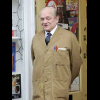Just received from the BRDC - a really fine and capable gentleman engineer, aviator, racer, has left us...
The Club Office has just learned that one of our oldest Members, Mike Oliver, died last Wednesday, 15th July. He was 99 years old and had been a Full Member since 1949.
After serving in the Royal Air Force during World War 2, Mike competed in early post war motor sport events in a variety of sports cars including an Alfa Romeo 1750 Zagato and T35B and T59 Bugattis. The interest in the French cars in particular led to him joining forces with Rodney Clarke who had set up in business as Continental Cars at Send in Surrey. Mike joined the company initially as service manager, becoming a director in 1947. The original plan to become Bugatti dealers was rather thwarted by the fact that post war the French manufacturer was producing very few cars. However, following an approach from Maserati racer Kenneth McAlpine, offering to fund the construction of a racing sports car, the Lea-Francis 14 hp Sports became the basis for the L series of Connaughts, one of which was raced by Mike.
While Rodney Clarke was responsible for chassis design and development, Mike took care of engine development. The success enjoyed by the sports car encouraged the triumvirate to produce their first single-seater, the A-type, which first raced at Castle Combe in October 1950, finishing second in the up to 2500 cc racing car race in the hands of Ken McAlpine behind the HWM of Stirling Moss. It was only a few weeks earlier that Stirling had rocked the motor racing establishment by convincingly winning the RAC Tourist Trophy in Tommy Wisdom’s Jaguar XK120. Mike had also contested that TT, not in a Connaught but in a Healey Silverstone with which he finished 15th overall. His first chance to race the single-seater came in the Rufford Stakes at Gamston in July 1951 where he retired with a throttle linkage problem.
Rodney and Mike set themselves very high standards so that the Connaughts were beautifully engineered and durable. With Formula 2 becoming the World Championship category in 1952 and ’53, there was the chance to compete at the highest level although the cars were principally campaigned in the plethora of British F2 and similar races. Most notable was the 1952 British Grand Prix at Silverstone in which A-types finished fourth (Dennis Poore) and fifth (Eric Thompson). Later that year Mike had the opportunity to race an A-type at Charterhall in Scotland, snatching third place on the last lap from Stirling Moss’s ERA G-type to give Connaught the first three places as Dennis Poore and Ken McAlpine finished first and second in the Newcastle Journal Trophy race.
The 2.5 litre Formula 1 was introduced for 1954 for which Connaught created the B-type powered by an Alta engine from which Mike extracted rather more horsepower than it produced when first delivered by its manufacturer. The car, with its striking full width aerodynamic bodywork, was revealed to the world in August 1954 but did not race until Easter at Goodwood the following year. Towards the end of a promising first season, an offer of generous starting money led to Connaught team entering two cars in the Gran Premio di Siracusa at the end of October. Dental student Tony Brooks made his F1 debut and saw off a strong field of Maseratis to bring Connaught a famous victory.
Hopes were high but funds were low for 1956 when it proved impossible for the team to undertake a full World Championship season. Mike had had a chance to race the B-type at Snetterton in July 1955, finishing fourth in a formule libre race won by Tony Rolt in Rob Walker’s A-type from sometime Connaught driver Roy Salvadori in the Gilby Engineering Maserati 250F. Mike had one further outing, in the 1956 BRDC Daily Express International Trophy, in an open-wheel B-type, now known as the Syracuse after Tony Brooks’s success the previous Autumn. Unfortunately it went badly wrong, brake problems causing Mike to crash heavily at Woodcote Corner. Thrown from the car, Mike sustained a broken shoulder and did not race again. By this time the writing was already on the wall for the future of Connaught in Formula 1 so that, despite a worthy third place for Ron Flockhart in the 1956 Italian Grand Prix and victory for Stuart Lewis-Evans in the Glover Trophy at Goodwood on Easter Monday the following year, economic reality meant that there was no alternative but to close down the racing team, the assets of which were auctioned in September 1957.
During the Connaught period, Mike had maintained his aviation connections as a member of the Auxiliary Air Force which the government disbanded in 1957. Mike joined Folland, manufacturers of the Gnat, the trainer version of which was used by the Red Arrows, and in 1964 became the company’s chief test pilot. After retiring from active flying he then took on responsibility for Hawker Siddeley’s custom liaison. He retained his interest in motor racing and Connaughts in particular, and was a distinguished guest at the Connaught reunion in 1999.
As the years pass, fewer and fewer personalities remain from the days when the United Kingdom was struggling to establish itself at the highest level of motor racing. Mike Oliver and Rodney Clarke, with the financial and enthusiastic support of Ken McAlpine and the driving talents of Tony Brooks, laid the foundation for the UK domination of the sport which followed. The BRDC offers its most sincere condolences to Mike’s daughter Melanie and his sons John and Tim and their families.
DCN














